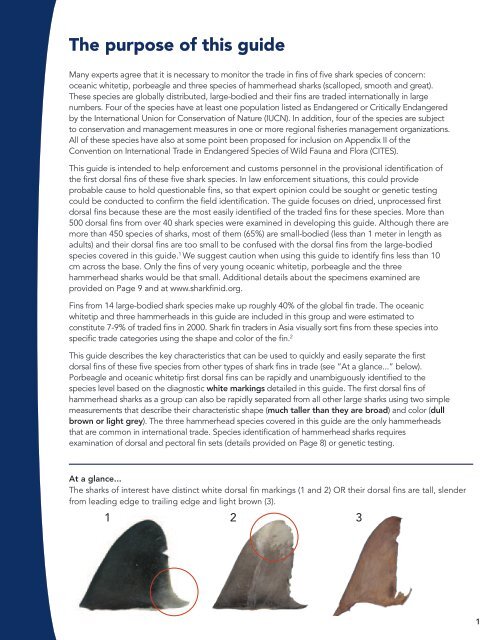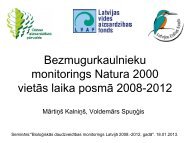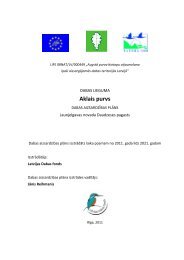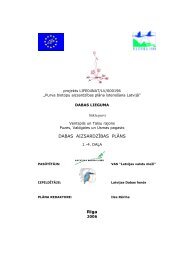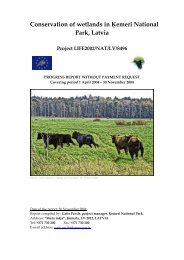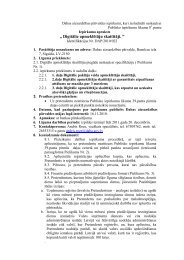Identifying Shark Fins:
Identifying Shark Fins:
Identifying Shark Fins:
Create successful ePaper yourself
Turn your PDF publications into a flip-book with our unique Google optimized e-Paper software.
The purpose of this guide<br />
Many experts agree that it is necessary to monitor the trade in fins of five shark species of concern:<br />
oceanic whitetip, porbeagle and three species of hammerhead sharks (scalloped, smooth and great).<br />
These species are globally distributed, large-bodied and their fins are traded internationally in large<br />
numbers. Four of the species have at least one population listed as Endangered or Critically Endangered<br />
by the International Union for Conservation of Nature (IUCN). In addition, four of the species are subject<br />
to conservation and management measures in one or more regional fisheries management organizations.<br />
All of these species have also at some point been proposed for inclusion on Appendix II of the<br />
Convention on International Trade in Endangered Species of Wild Fauna and Flora (CITES).<br />
This guide is intended to help enforcement and customs personnel in the provisional identification of<br />
the first dorsal fins of these five shark species. In law enforcement situations, this could provide<br />
probable cause to hold questionable fins, so that expert opinion could be sought or genetic testing<br />
could be conducted to confirm the field identification. The guide focuses on dried, unprocessed first<br />
dorsal fins because these are the most easily identified of the traded fins for these species. More than<br />
500 dorsal fins from over 40 shark species were examined in developing this guide. Although there are<br />
more than 450 species of sharks, most of them (65%) are small-bodied (less than 1 meter in length as<br />
adults) and their dorsal fins are too small to be confused with the dorsal fins from the large-bodied<br />
species covered in this guide. 1 We suggest caution when using this guide to identify fins less than 10<br />
cm across the base. Only the fins of very young oceanic whitetip, porbeagle and the three<br />
hammerhead sharks would be that small. Additional details about the specimens examined are<br />
provided on Page 9 and at www.sharkfinid.org.<br />
<strong>Fins</strong> from 14 large-bodied shark species make up roughly 40% of the global fin trade. The oceanic<br />
whitetip and three hammerheads in this guide are included in this group and were estimated to<br />
constitute 7-9% of traded fins in 2000. <strong>Shark</strong> fin traders in Asia visually sort fins from these species into<br />
specific trade categories using the shape and color of the fin. 2<br />
This guide describes the key characteristics that can be used to quickly and easily separate the first<br />
dorsal fins of these five species from other types of shark fins in trade (see “At a glance...” below).<br />
Porbeagle and oceanic whitetip first dorsal fins can be rapidly and unambiguously identified to the<br />
species level based on the diagnostic white markings detailed in this guide. The first dorsal fins of<br />
hammerhead sharks as a group can also be rapidly separated from all other large sharks using two simple<br />
measurements that describe their characteristic shape (much taller than they are broad) and color (dull<br />
brown or light grey). The three hammerhead species covered in this guide are the only hammerheads<br />
that are common in international trade. Species identification of hammerhead sharks requires<br />
examination of dorsal and pectoral fin sets (details provided on Page 8) or genetic testing.<br />
At a glance...<br />
The sharks of interest have distinct white dorsal fin markings (1 and 2) OR their dorsal fins are tall, slender<br />
from leading edge to trailing edge and light brown (3).<br />
1 2 3<br />
1


